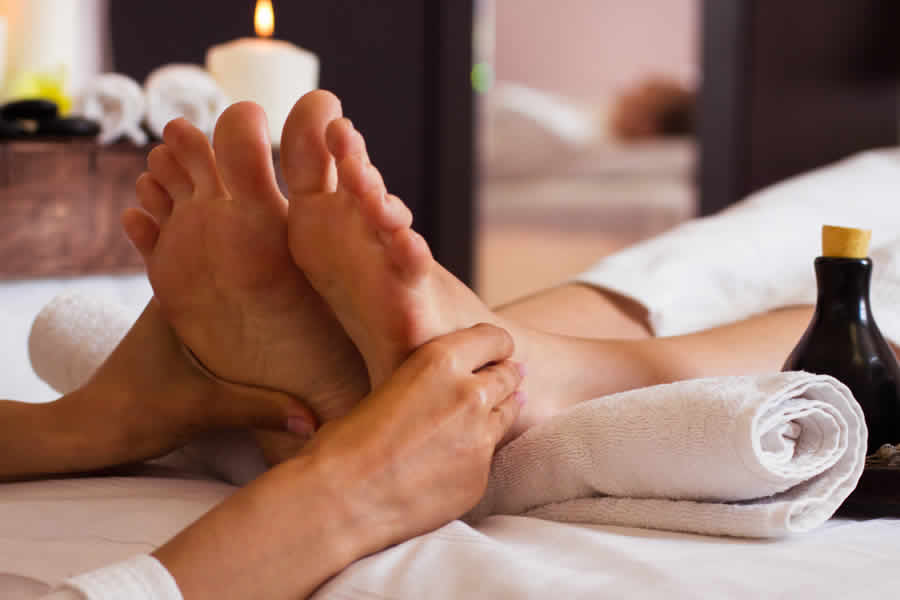
Reflexology is the holistic understanding, study and practice of treating points and areas in the feet and hands that relate to corresponding parts of the body. Using precise hand and finger techniques, a reflexologist may improve circulation, induce relaxation and enable homeostasis. This encourages the person’s own healing systems to be activated to maintain wellbeing.
Reflexology is a gentle healing art which dates to ancient Egypt and China. An indication that even then the benefits of this therapy were strongly acknowledged can be seen in Egyptian tomb artwork dating from around 2000BC. This depicts a scene of the giving and receiving of foot massage.
It was not until 1913 that Dr William Fitzgerald introduced this therapy to the West. He found that the application of pressure to one part of the body could create a response in another. This reflex relationship was found to lie within certain longitudinal zones of which there were ten in the body. Fitzgerald called this the science of “zone therapy”.
In the 1930’s a young physiotherapist called Eunice Ingham further developed the study of zone therapy into reflexology as we know it today. It was she who determined that the reflexes on the feet and hands were an exact mirror image of the organs of the body.
Reflexology is a complementary therapy, which works on the feet to assist in restoring homeostasis to the whole person not just the prevailing symptoms.
Who can benefit from reflexology?
Reflexology is suitable for all ages and may bring relief from a wide range of acute and chronic conditions. After you have completed a course of reflexology treatment for a specific condition, many people find it beneficial to continue with regular treatments in order to maintain health and well-being.
While many people use reflexology as a way of relaxing the mind and body and counteracting stress, at the same time many doctors, consultants and other health care professionals recognise reflexology as a well-established, respected and effective therapy.
With ever increasing levels of stress, it is important people take more responsibility for their own health care needs. Reflexology helps us to cope on a physical, mental and emotional level thereby encouraging us to heal and maintain health in all areas of our lives.
What happens when I go for treatment?
Consultation:
On the first visit, the reflexology practitioner will conduct a full personal consultation. This will take into consideration your past and present health and lifestyle. The consultation enables the treatment to be tailored to your specific needs.
In some instances it may be necessary to gain your doctors permission before treatment can commence.
All this will be discussed on a confidential basis with your chosen practitioner.
The Reflexology Treatment:
A reflexology treatment lasts for approximately one hour. As it is the feet which are generally treated you simply remove your socks and shoes. You will be invited to sit or lie on a comfortable treatment chair or couch.
The reflexologist will then use their hands to apply precise pressure techniques to the feet treating specific points which correspond to all organs and systems of the body.
Following treatment, any significant findings will be discussed with you. As the effects of reflexology are cumulative, many people find it beneficial to continue with regular treatments.
How will I feel after a reflexology treatment?
In order to gain maximum benefit from your reflexology treatment try to rest and take things easy as this helps to boost the body’s natural healing abilities. Increasing the amount of water that you drink can help to flush the toxins out of your system thereby aiding the detoxifying process
Just listen to your body and put aside time to relax. After one or two treatments your body may respond in a very definite way. Most people note a sense of well-being and relaxation; sometimes people report feeling lethargic, nauseous or tearful, but this is transitory and is a part of the healing process.
This is vital information to feed back to the reflexologist as it shows how your body is responding to treatment. This will help the reflexologist to tailor a treatment plan specific to your needs.
Reflexology Lymphatic Drainage
What is Reflexology Lymphatic Drainage, (RLD) ?
RLD is an award-winning reflexology technique which focuses on stimulating the lymphatic reflexes on the feet. The aim of RLD is to cause positive effect on the lymphatic system in the body. It is a unique sequence that has been researched and developed by Sally Kay BSc (Hons), whilst working in Cancer Care.
The Studies support the theory that RLD will reduce the problem with Lymphoedema which may occur as a result of treatment of breast cancer, prostate cancer, cancer of the womb, cervix or ovary or other invasive cancers. R.L.D may also be useful in the following conditions: Fibromyalgia, Rheumatoid Arthritis, ME, Allergies, I.B.S, Colitis, Sinus, Asthma, etc…
Pregnancy Reflexology
Are you having fertility issues? or are you pregnant?
A Course of reflexology treatments can aid with both. It will help to ease the stress with either getter pregnant and stimulate the reproductive system for both women and man. Reflexology will also support the woman throughout the pregnancy with the changes that are happening as the pregnancy progresses, also preparing your body for the birth.
Baby Reflexology
Reflexology has many benefits for both babies and children as a result of the reflexology treatment, the child will be calmer, which will benefit the whole family. It will help with teething, digestion problems and aid in a more restful sleep. Reflexology will also help with their development both mentally and physically

